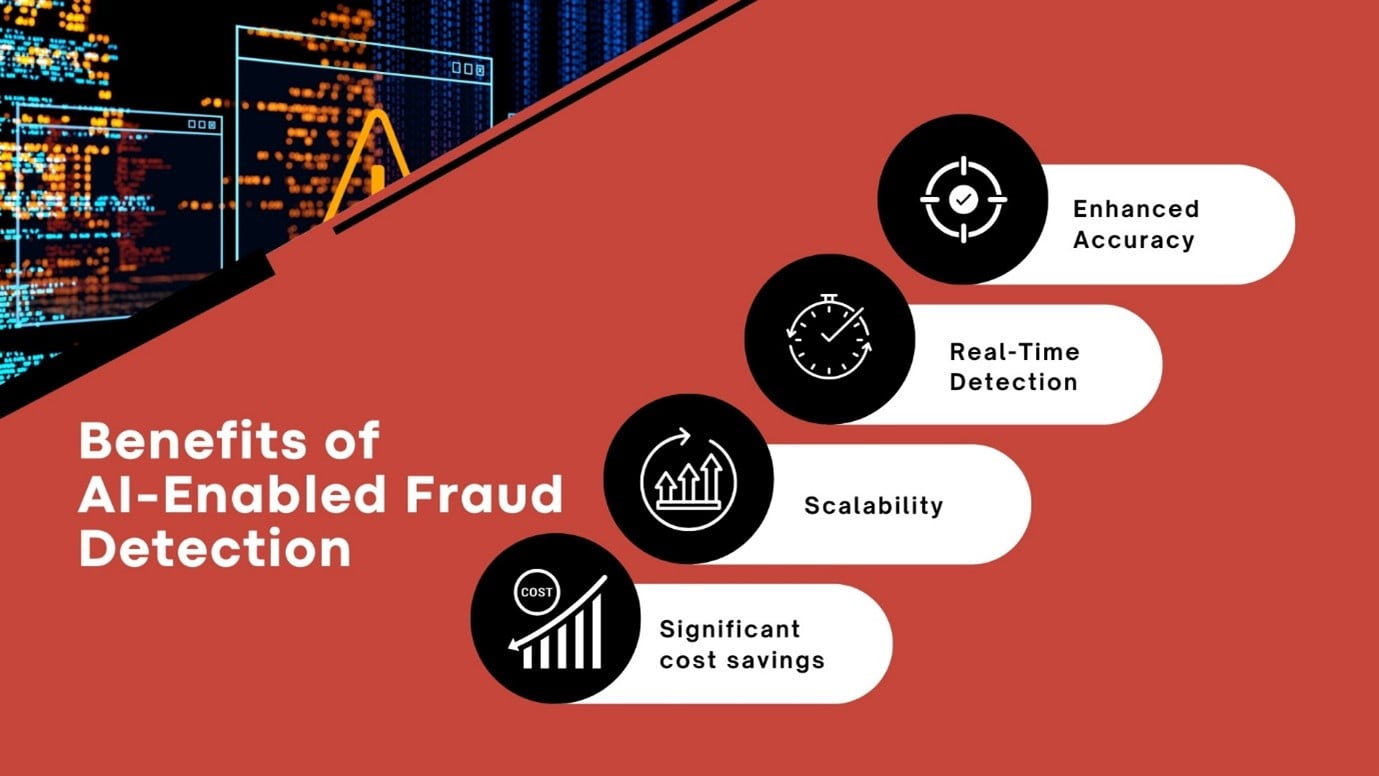AI-enabled fraud detection in GRC

Businesses are up against a massive challenge: fraud. The Association of Certified Fraud Examiners (ACFE) released a shocking fact stating that companies are losing about 5% of their earnings to fraud every year. That adds up to a global loss of approx. $4 trillion, a number that’s both shocking and a clear sign of how big the problem is. With fraud being so widespread, the old ways of catching it, which often depend on looking at things manually and after the fact, just aren’t cutting it anymore.
That’s where Artificial Intelligence (AI) comes into play. In recent years, AI has become a powerful weapon in the fight against fraud, especially in Governance, Risk Management, and Compliance (GRC). By using AI, businesses aren’t just reacting to fraud after it happens; they can now predict and stop it before it occurs. This change is turning the tables in the battle against fraud, giving businesses a much-needed edge in their fight against dishonesty and trickery.
The Role of AI in Fraud Detection
Artificial Intelligence, with its remarkable ability to process and analyze vast amounts of data at incredible speeds, is ideally suited for the complex and data-rich Governance, Risk, and Compliance (GRC) world. In this context, AI is not merely a tool but a transformative force reshaping how risk management and compliance are approached. By leveraging AI’s capabilities, organizations can sift through enormous volumes of data to uncover hidden patterns, anomalies, and trends that may indicate fraudulent activity.
One of the standout features of AI in GRC is its adaptability. Unlike traditional systems, AI algorithms can learn and evolve, continuously enhancing their ability to detect fraud. This dynamic nature of AI is essential in keeping up with fraudsters’ constantly changing tactics.
Critical Benefits of AI-Enabled Fraud Detection

- Enhanced Accuracy: AI algorithms can analyze data with a precision that human analysts cannot match. This accuracy is critical in reducing false positives and negatives, ensuring that legitimate transactions are not flagged as fraudulent and that fraudulent ones are not overlooked.
- Real-Time Detection: The fast-paced nature of the finance and commerce industry means speed is of the essence. AI systems can monitor real-time transactions, providing immediate alerts when suspicious activity is detected. This rapid response is crucial in preventing fraud before it can cause significant harm.
- Scalability: As organizations grow, so does the volume of data they generate. AI systems can quickly scale to handle this increasing data load, ensuring that fraud detection capabilities remain robust and effective regardless of the organization’s size.
- Cost-Effectiveness: Implementing AI for fraud detection can lead to significant cost savings. By automating the detection process, organizations can reduce their reliance on manual labor, which is both time-consuming and expensive. By preventing fraud, AI can also save organizations from potential financial losses and reputational damage.
AI is not just a futuristic concept but a practical and powerful tool that can revolutionize how organizations approach fraud detection in GRC.
Real-life Examples of AI in Action
- HSBC Bank: HSBC, one of the world’s largest banking and financial services organizations, has adopted AI to enhance its fraud detection capabilities. By using machine learning algorithms, HSBC can analyze vast amounts of transaction data to identify patterns and anomalies indicative of fraudulent activity. This proactive approach has enabled the bank to reduce false positives by 20%, improving the efficiency of its fraud detection efforts.
- Amazon: Amazon, the e-commerce giant, utilizes AI to combat fraud on its platform. The company employs machine learning models to analyze customer behavior, transaction history, and product information to detect and prevent fraudulent transactions. This AI-driven approach has been instrumental in maintaining the integrity of Amazon’s marketplace and protecting its customers from fraud.
- JPMorgan Chase & Co.: JPMorgan Chase & Co., one of the largest banking institutions in the United States, implemented an AI-driven fraud detection system called COIN (Contract Intelligence). This system uses machine learning algorithms to analyze transaction patterns and detect anomalies indicative of fraud. COIN has been instrumental in reducing the number of false positives, improving fraud detection accuracy, and saving the bank an estimated 360,000 hours of manual work annually.
Types of Fraud and How AI Addresses Them
- Identity Theft: Identity theft is a prevalent form of fraud that involves the unauthorized use of someone’s personal information for illicit purposes. AI can address identity theft issues by analyzing patterns in user behavior and transaction data to detect anomalies that may indicate identity theft. For instance, if an account suddenly exhibits unusual purchasing patterns or login attempts from a new location, AI algorithms can flag these activities for further investigation.
- Payment Fraud: Payment fraud encompasses various fraudulent activities related to payment transactions, including credit card fraud, wire transfer fraud, and mobile payment fraud. AI systems help prevent payment fraud by continuously monitoring transactions for signs of suspicious activity, such as unusual transaction amounts, frequency, or locations. By identifying these anomalies in real-time, AI can alert organizations to potential fraud, allowing them to take immediate action.
- Healthcare Fraud: Healthcare fraud involves fraudulent claims or billing practices in the healthcare industry. AI can help detect healthcare fraud by analyzing billing data and medical records to identify discrepancies, such as duplicate claims, inflated charges, or services not rendered. By uncovering these irregularities, AI assists healthcare providers and insurers in preventing fraudulent claims and ensuring the integrity of the healthcare system.
- Cyber Fraud: Cyber fraud refers to fraudulent activities through digital channels, such as phishing, malware, and online scams. AI plays a crucial role in combating cyber fraud by analyzing network traffic, email patterns, and user behavior to detect signs of malicious activity. Machine learning algorithms can identify phishing emails by analyzing their content, structure, and sender information, while AI-driven security systems can detect and neutralize malware before it can cause harm.
Challenges and Considerations in implementing AI for fraud detection
Navigating the complexities of implementing AI for fraud detection involves addressing several key challenges and considerations, all while ensuring a smooth flow of information.
- Data Privacy and Security: One of the foremost concerns is safeguarding sensitive data. This involves implementing robust encryption protocols for data at rest and in transit, establishing strict access controls, and conducting regular security audits and monitoring to promptly detect and respond to potential threats. Compliance with regulations such as GDPR and HIPAA is also crucial.
- Algorithmic Bias: Algorithmic bias can lead to unfair outcomes, such as certain transactions or customers being incorrectly flagged as fraudulent. To mitigate this, it’s essential to ensure that the training data for AI models is diverse and representative, develop transparent and explainable AI models, continuously evaluate bias models, and involve stakeholders from diverse backgrounds in the development process.
- Regulatory Compliance: The regulatory landscape surrounding AI and fraud detection constantly evolves. Staying informed, maintaining thorough documentation and reporting practices, collaborating with regulators, and adhering to ethical frameworks are essential for compliance.
- Integration with Existing Systems: Integrating AI into existing GRC systems can be challenging due to compatibility issues and the need for a multidisciplinary approach. Conducting compatibility assessments, adopting a phased implementation approach, forming cross-functional teams, and providing continuous training and support are crucial to ensuring a smooth integration process.
Strengthen Fraud Detection with iTech GRC
At iTech GRC, we understand the challenges businesses face in combating fraud. That’s why we’ve developed cutting-edge solutions that harness the power of artificial intelligence (AI) to detect and prevent fraudulent activities. By leveraging advanced AI algorithms, our platform can analyze vast amounts of data in real-time, swiftly identifying suspicious patterns and anomalies that may indicate fraudulent behavior. This proactive approach helps organizations mitigate risks, enhances operational efficiency, and ensures regulatory compliance. With iTech GRC’s AI-enabled fraud detection, businesses can stay one step ahead of fraudsters, safeguarding their reputation and financial well-being.
FAQs
- How does AI detect fraud in GRC?
AI detects fraud by analyzing data patterns and identifying anomalies that may indicate fraudulent activity. It can sift through vast amounts of data much faster and more accurately than humans, making it an effective tool for detecting suspicious behavior.
- What are the benefits of using AI in fraud detection?
Using AI in fraud detection offers several benefits. First, it can significantly improve accuracy by detecting patterns and anomalies that may be missed by manual methods. Second, AI can help reduce costs by automating many aspects of fraud detection, which can be labor-intensive and time-consuming. Third, AI can enhance predictive capabilities, allowing organizations to anticipate and prevent fraud before it occurs.
- Are there any risks associated with AI-enabled fraud detection?
While AI-enabled fraud detection offers many benefits, there are also risks to consider. One concern is data privacy, as AI systems require access to large amounts of data to function effectively. This raises questions about how organizations can ensure the security and privacy of sensitive information. There are also ethical issues to consider, such as how AI systems are trained and the potential for bias in their decision-making processes. Additionally, there is a risk that AI systems could be manipulated or exploited by fraudsters if not properly secured.
- How can organizations implement AI in their GRC framework?
Organizations can implement AI in their GRC framework by following a few key steps. First, they should assess their needs and identify areas where AI can provide the most value, such as fraud detection, risk assessment, or compliance monitoring. Next, they should choose appropriate AI tools and technologies that align with their goals and capabilities. Finally, organizations should ensure seamless integration of AI into their existing GRC systems and processes to maximize its effectiveness.
